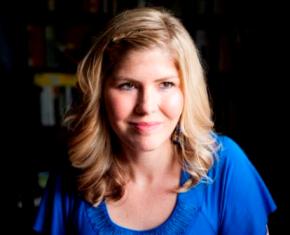 Keija Parssinen was born in Saudi Arabia and lived there for twelve years as a third-generation expatriate. She is a graduate of Princeton University and the Iowa Writers' Workshop, where she received a Truman Capote fellowship, a Teaching and Writing fellowship, and a Michener-Copernicus award for her first novel, The Ruins of Us, forthcoming from Harper Perennial in North America and Faber & Faber in the UK, Ireland, South Africa, and Australia in January 2012. Here she talks about the gold bracelets her mother gave her when her family left Saudi Arabia and moved to the United States.
Keija Parssinen was born in Saudi Arabia and lived there for twelve years as a third-generation expatriate. She is a graduate of Princeton University and the Iowa Writers' Workshop, where she received a Truman Capote fellowship, a Teaching and Writing fellowship, and a Michener-Copernicus award for her first novel, The Ruins of Us, forthcoming from Harper Perennial in North America and Faber & Faber in the UK, Ireland, South Africa, and Australia in January 2012. Here she talks about the gold bracelets her mother gave her when her family left Saudi Arabia and moved to the United States.
My mother keeps her memories heavy on her arms, in the form of gold bangles which she, and my grandmother before her, collected during decades spent living in and traveling around the Middle East. She wears them stacked ten deep --- there’s the broad cuff with floral engravings, the ornate bracelet with lacy flowers carved from the soft 24-karat gold, and the thick one with the Florentine finish that displays the Saudi national emblem, the crossed swords beneath a date palm. For me, the sound of my mother will always be the jangling of gold, a tinny clinking that made her easy to track through our home at the edge of the Dahna desert in the Eastern Province of Saudi Arabia. Grandma Willette and mom bought their bangles in Beirut and Cairo, and in the souks of Manama,al-Dammam, and al-Khobar, the city where I was born.
When I was 11, my parents told me we were leaving Saudi Arabia “for good,” the phrase expatriates used when they left, because without a job in the Kingdom, it was nearly impossible to secure a visa and return. I cried mightily the night I learned of our departure --- there would be no more shwarmas from the Khobar street vendors, no more tumbling into the sea from the top of the hulking dune at Half Moon Bay, the expat beach. We were moving to Austin, a place I’d never been.
Before my family left Saudi Arabia, my mother went to Madina Jewlers in Khobar and bought two thin bangles, one set for me and one for my sister. She bought them small so that she had to fight to get them on our narrow child-wrists. “In Saudi Arabia, children wear their bangles until they outgrow them, and then a jeweler snips them off,” she explained. The bands glittered wildly, the richness of the ore evidenced in the yolk-yellow color. On the plane out of the Kingdom, I held mine close to my ear, listening for the empty sound of the desert. In Texas, the bracelets became my talismans of Arabia. Now I clinked softly, too; I wore my memories around my wrist, like my mother.
At school in the States, I took up sports and found I had a talent for basketball. I joined a competitive squad, and on the night of our first game, when I went to greet the other captain and shake hands with the refs, one of whom immediately noticed my bracelets. “No jewelry allowed,” he said. Try as I might, the bracelets wouldn’t budge from my wrist. I’d had a growth spurt over the summer, my bangles becoming a part of me, so that I showered and slept in them, taking comfort in the memories they restored to me. That night, the refs let me cover them with a sweatband, as long as I had them removed before the next game. I contemplated quitting basketball to keep my bracelets --- at that point cutting them off would be like losing a finger. And yet I loved the game --- the exhilarationof it, my new friends. I decided to amputate.
The next day, mom took me to a local jeweler. With two snips, the metal fell from my wrist. At home, I stored them in my miniature Kuwaiti chest, where I kept the letters from my friends in Saudi, as well as a tiny vial of sand from the Rub al-Khali. The jagged edges where the bracelets had been severed depressed me, perfectly signifying my own sundering from my home. That season, my team won the league and I became Most Valuable Player. I’d learned to pivot and feint, and to drive the basket, but these new gifts did little to replace my missing bangles.
In Christmas of 2007, just before I returned to Saudi Arabia to visit my father, who had returned overseas, my mother presented me with a small maroon box with faded gold Arabic script on it. “Madina Jewelers,” it read in English. Inside were two gold hoop earrings. Immediately, I recognized the rope pattern from my Saudi bangles. Mom had unearthed the bracelets from my chest and had had one of them repurposed into earrings, which I could take on and off as necessary, and would never grow out of. I wear them nearly every day, and though I miss the soft clink they made on my wrist, they still serve to remind me of home, and of my beautiful mother.


